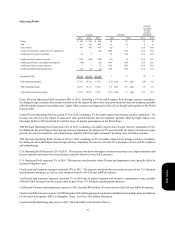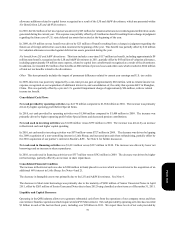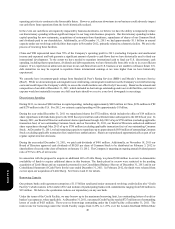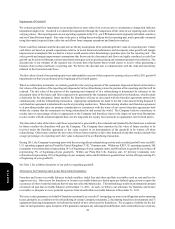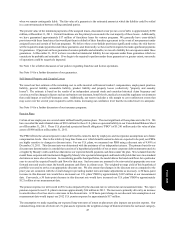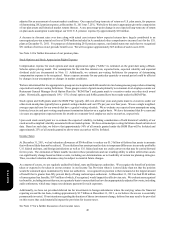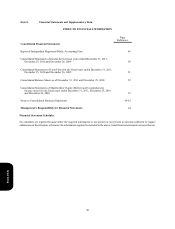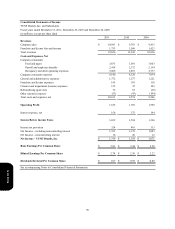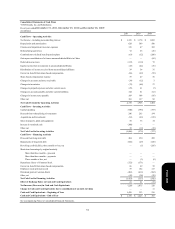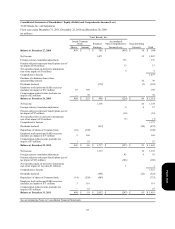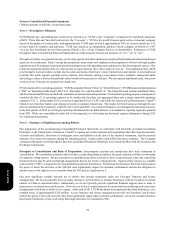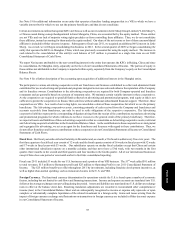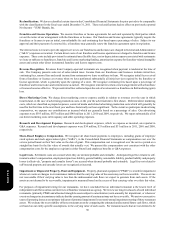Pizza Hut 2011 Annual Report Download - page 150
Download and view the complete annual report
Please find page 150 of the 2011 Pizza Hut annual report below. You can navigate through the pages in the report by either clicking on the pages listed below, or by using the keyword search tool below to find specific information within the annual report.
46
adjusted for an assessment of current market conditions. Our expected long-term rate of return on U.S. plan assets, for purposes
of determining 2012 pension expense, at December 31, 2011 was 7.25%. We believe this rate is appropriate given the composition
of our plan assets and historical market returns thereon. A one percentage-point change in our expected long-term rate of return
on plan assets assumption would impact our 2012 U.S. pension expense by approximately $10 million.
A decrease in discount rates over time along with actual asset returns below expected returns have largely contributed to an
unrecognized pre-tax actuarial net loss of $540 million included in Accumulated other comprehensive income (loss) for the U.S.
plans at December 31, 2011. For purposes of determining 2011 pension expense, our funded status was such that we recognized
$31 million of net loss in net periodic benefit cost. We will recognize approximately $63 million of such loss in 2012.
See Note 14 for further discussion of our pension plans.
Stock Options and Stock Appreciation Rights Expense
Compensation expense for stock options and stock appreciation rights (“SARs”) is estimated on the grant date using a Black-
Scholes option pricing model. Our assumptions for the risk-free interest rate, expected term, expected volatility and expected
dividend yield are documented in Note 15. Additionally, we estimate pre-vesting forfeitures for purposes of determining
compensation expense to be recognized. Future expense amounts for any particular quarterly or annual period could be affected
by changes in our assumptions or changes in market conditions.
We have determined that it is appropriate to group our stock option and SAR awards into two homogeneous groups when estimating
expected term and pre-vesting forfeitures. These groups consist of grants made primarily to restaurant-level employees under our
Restaurant General Manager Stock Option Plan (the “RGM Plan”) and grants made to executives under our other stock award
plans. Historically, approximately 10% - 15% of total options and SARs granted have been made under the RGM Plan.
Stock option and SAR grants under the RGM Plan typically cliff-vest after four years and grants made to executives under our
other stock award plans typically have a graded vesting schedule and vest 25% per year over four years. We use a single weighted-
average expected term for our awards that have a graded vesting schedule. We re-evaluate our expected term assumptions using
historical exercise and post-vesting employment termination behavior on a regular basis. We have determined that five years and
six years are appropriate expected terms for awards to restaurant-level employees and to executives, respectively.
Upon each stock award grant we re-evaluate the expected volatility, including consideration of both historical volatility of our
stock as well as implied volatility associated with our traded options. We have estimated pre-vesting forfeitures based on historical
data. Based on such data, we believe that approximately 50% of all awards granted under the RGM Plan will be forfeited and
approximately 25% of all awards granted to above-store executives will be forfeited.
Income Taxes
At December 31, 2011, we had valuation allowances of $368 million to reduce our $1.3 billion of deferred tax assets to amounts
that will more likely than not be realized. The net deferred tax assets primarily relate to temporary differences in currently profitable
U.S. federal and state, and foreign jurisdictions as well as U.S. federal and state tax credit carryovers that may be carried forward
for ten years. The estimation of future taxable income in these jurisdictions and our resulting ability to utilize deferred tax assets
can significantly change based on future events, including our determinations as to feasibility of certain tax planning strategies.
Thus, recorded valuation allowances may be subject to material future changes.
As a matter of course, we are regularly audited by federal, state and foreign tax authorities. We recognize the benefit of positions
taken or expected to be taken in our tax returns in our Income Tax Provision when it is more likely than not that the position
would be sustained upon examination by these tax authorities. A recognized tax position is then measured at the largest amount
of benefit that is greater than fifty percent likely of being realized upon settlement. At December 31, 2011 we had $348 million
of unrecognized tax benefits, $197 million of which, if recognized, would impact the effective tax rate. We evaluate unrecognized
tax benefits, including interest thereon, on a quarterly basis to ensure that they have been appropriately adjusted for events, including
audit settlements, which may impact our ultimate payment for such exposures.
Additionally, we have not provided deferred tax for investments in foreign subsidiaries where the carrying values for financial
reporting exceed the tax basis, totaling approximately $1.7 billion at December 31, 2011, as we believe the excess is essentially
permanently invested. If our intentions regarding the duration of theses investments change, deferred tax may need to be provided
on this excess that could materially impact the provision for income taxes.
See Note 17 for a further discussion of our income taxes.
Form 10-K



